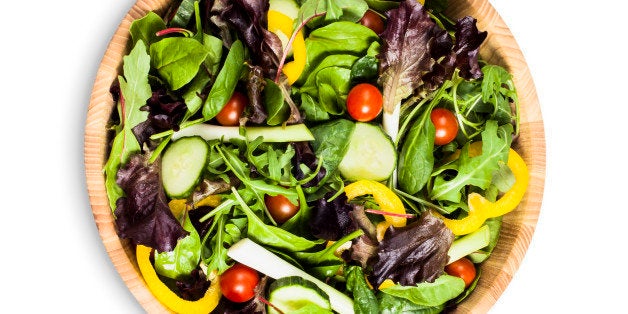
As a nutritionist, I am a huge fan of salads. After all, colorful veggies are great -- chock full of nutrients without too many calories. However, just because you order a salad when you go out, (while thinking you are being virtuous), does not necessarily mean that it is good for your waistline. The mantra "I'll just have a salad" can be a dieter's dream or a diet disaster depending on what goes into that salad.
For example, the chicken Caesar salad at The Cheesecake Factory contains a whopping 1,510 calories. That is the number of calories that certain people should eat in an entire day. It contains globs of dressings, croutons, and more. And the Quesadilla Explosion Salad at Chili's contains 1,430 calories. Many sandwiches contain far fewer calories. Who would have guessed?
So next time you order a salad, get a custom blend if possible, and follow these tips. You'll save lots of calories while getting plenty of nutrients.
1. Choose an assortment of deep greens.
Romaine lettuce, kale, and spinach are great choices, high in fiber, folate, and vitamin C. Skip the iceberg lettuce, which is mostly water, and not nearly as many nutrients as the deeper greens.
2. Add a mix of colorful non-starchy vegetables.
Adding an assortment of colorful vegetables are your best option, as the different colors impart different nutrients. Throw in some orange veggies such as carrots which are rich in contain beta carotene and add tomatoes which contain lycopene. Other great options are vitamin C-rich yellow and red peppers, broccoli, cucumbers, and mushrooms. You get the idea. It's okay to throw in the kitchen sink, as they say.
3. Add a healthy protein.
Add grilled salmon, chicken breast, canned tuna, or sliced turkey as a healthy protein option. Aim for around 4 ounces (a little larger than your palm). Tofu or tempeh makes for a great vegan option. Protein is filling and also helps to stabilize blood sugar. Skip the fried chicken, fried fish, and fatty deli meats such as pastrami. And go easy on the cheese.
4. Toss in your favorite beans or legumes.
If you have the urge, toss in some beans or legumes for flavor and added fiber. Chick peas, black beans, kidney beans or lentils are great options. Aim for around 1/2 cup (looks like a cupped hand.) Beans and legumes will add more substance to the salad along with fiber and nutrients. And they will certainly keep you full. But best to skip the re-fried beans.
5. Go easy on the dressing.
Salad dressing is high in calories and fat, and we usually get way too much dressing when we order a salad straight off the menu without specifying "light on dressing" or "on the side." It is common for a restaurant salad to contain at least a quarter of cup, or 4 tablespoons of dressing. I suggest asking for dressing on the side, and then you can control how much you add. It's also important to watch your portion when you are home, as a mere tablespoon of oil (while containing heart-healthy fat) contains over 100 calories. When choosing a dressing, best to aim for non-creamy dressings such as balsamic vinaigrette, Italian, or use olive oil and vinegar along with your favorite spices. Skip the ranch, Caesar, and blue cheese. When eating at home, try making your own dressing with olive oil, mustard, vinegar, and fresh lemon. Or choose a low-cal dressing. Aim for 1-2 tablespoons (or a shot glass worth) of dressing.
We would love to hear your favorite salad tips and recipes.